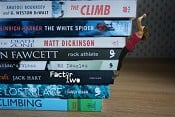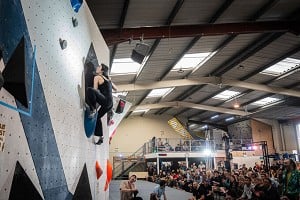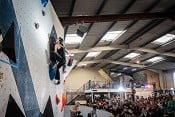
So a new bouldering gym opened up, nicely kitted out and very much the modern take with lots of volumes... https://www.urbanclimb.com.au/collingwood/
Now it's been a while since I had to sit thru a tedious induction*... but I was amazed that there was no discussion, guidance or mention of spotting other climbers. Watching other people climb this played out as there was almost no spotting, including in some very awkward body positions (horizontal @3m up).
Is this a common thing in the UK? I wondered if it was trickle down from the international comp scene? Or I am just getting old and grumpy and don't understand young people these days?
LD
*I know, has to be done etc.
Spotting indoors is very rare in my (UK and Central Europe) experience. General consensus seems to be that with modern matting there are very few circumstances where it's useful. The main job of the spotter is to increase the chance of the climber landing on the mat, after all, and at the mats at most bouldering walls are hard to miss.
The main job of a spotter is to stop you Landing on your neck should you fall from a position other than vertical with feet down.
I'm somewhat young (26) and sometimes use a spotter, particularly on steep stuff/ near the edge of a mat. The most important thing they do for me is to ensure that no-one walks below me at the point where I am struggling with the crux moves! This said, I rarely do anything where I feel I might land on my head.
> The most important thing they do for me is to ensure that no-one walks below me at the point where I am struggling with the crux moves!
Exactly. Even when I'm on my own there's a few key spots where I'll ask somebody I know to spot me because people always seem to walk around the corner at the wrong moment.
> The main job of a spotter is to stop you Landing on your neck should you fall from a position other than vertical with feet down.
Pretty hard to contrive such a position though, even on the steepest ground. If it is, the setting is probably not great, and should take things like this into consideration - lots of people go to the wall alone! (Never use a spotter indoors).
> Spotting indoors is very rare in my (UK and Central Europe) experience.
I see it quite a lot, largely among beginners - it seems to be taught on introductory courses and the like. Most of the time it's pretty counterproductive, the spotter would do better for the climber's safety as well as their own just stepping back and staying out of the way.
When it's busy indoors, there's a lot to be said for having a mate to manage the traffic but sometimes you need to be so assertive to prevent some idiot from wandering under a climber that it's a lot to ask of someone who is naturally a bit shy & reserved.
The Works would do well to have a little education campaign imo. Perhaps get one of the more assertive of their lovely staff to do the odd shift as a 'floor walker' when it's crazy busy in the evenings and remind people that there isn't space to congregate in doorways for a chat, or to sprawl all over the mats whilst resting between attempts*. (And that when they do, it's a *really* bad idea for others to just nip under someone climbing to avoid having to go through the middle of their group.)
* Seriously. The worst offenders are strong regulars who should know better. If you're *that* f*cking tired go sit on one of the comfy sofas.
Spotting on most indoor problems is counterproductive. With uniform soft matting, it is safer to allow the climber to plan their own landing without adding unexpected external forces from a spotter that reduces the time available for the climber to react before they hit the ground.
Occasionally, their are moves indoors where a spotter does make things safer. These are usually steeper climbs involving high heels/feet, heel-toe cams, poor handholds that you can fire off uncontrollably or big dynamic moves that are difficult to control. On these problems, we spot people.
You have to assess this for each problem and each move individually. This leads to not spotting on the vast majority of moves or problems.
As commented above, most beginners I see spotting are increasing the risk of injury, not reducing it.
Eh? It’s not difficult at all. In fact I would suggest that it’s harder not to create a situation where you’d come down anything but straight when trying hard (ie- not jumping off or letting go intentionally).
All it takes is a crimp or foot to pop, you rotate around the remaining points of contact and you’re spinning uncontrollably.
its not just necks, any lateral of rotational movement while hitting the mats can easily break legs and stamp ACLs. The amount of injuries at walls despite the ‘perfect’ mats is eveidence.
I’d agree that most of the time the most useful part of spotting is stopping people going under you, but making you land straight is a pretty big priority!
Maybe removing the mats from below the problems would encourage more spotting?
Or maybe moveable mats that people could move just as your attempting the crux move, as used to happen.
IMHO it's more dangerous than it's worth in most cases indoors. Chances of missing the mat are negligible and chances of toppling and hitting one's head after landing are similarly slight. Which begs the question what is the spotter there to do? In most cases, the answer seems to be to be a bystander, provided something awkward to land on and present the opportunity for two people to be injured.
Given that most walls now have rubber crumb matting under the lead walls, I cringe every time I see someone 'spotting' a climber starting on a lead route; the likely outcome if the spotter does actually make contact is broken fingers trapped in gear loops and banged heads as the spotter is drawn into the falling climber.
> Eh? It’s not difficult at all. In fact I would suggest that it’s harder not to create a situation where you’d come down anything but straight when trying hard (ie- not jumping off or letting go intentionally).
That's my point - obviously just didn't make it very well. If a problem forces you into a position where you will land on your head if you fall, it's badly set.
> All it takes is a crimp or foot to pop, you rotate around the remaining points of contact and you’re spinning uncontrollably.
> its not just necks, any lateral of rotational movement while hitting the mats can easily break legs and stamp ACLs. The amount of injuries at walls despite the ‘perfect’ mats is eveidence.
> I’d agree that most of the time the most useful part of spotting is stopping people going under you, but making you land straight is a pretty big priority!
> That's my point - obviously just didn't make it very well. If a problem forces you into a position where you will land on your head if you fall, it's badly set.
No, I understood your point. Being in that situation doesn’t denote bad routesetting (normally) it’s just a part of climbing. And can happen at any point.
Unbelievably wrong but each to their own.
I agree with you. I often spot where my partner is concerned with a spinning fall (and vice versa), so I think a partner ready to spot is always handy and keeps the moron traffic away (I blew my flash chance on a comp problem yesterday when a oblivious fool walked under my 90 kg as I just started to semi dyno the crux). I agree a bad spotter is worse than nothing but traffic control is always useful on a busy day (like comps always seem to be).
Preventable injuries from rotating falls are really common in indoor bouldering (I must see one a month at least that requires a trip to A&E) so I'm really surprised with some of the negative atttitudes towards spotting here. The main aim is just to ensure climbers hit the ground feet first and bouldering walls are not high enough that you need to be super careful with your hands if paying proper attention.
Maybe having a spotter when indoors is good training for outside. You have a spotter who has practiced in an environment where if they screw up you don't have injuries to show for it, and you can train them better!
Just a thought.
Back in the old days (10 years ago) I would agree. But nowadays barely any of the indoor climbers go outside or want to go outside so it’s a moot point now.
> Unbelievably wrong but each to their own.
My point entirely. But maybe you have a different opinion; if so, spit it out, dear heart.
My only 2 real climbing injuries (sorained ankle, torn disc) were both from indoor bouldering. In both cases I had a heel hook on a large incut hold that got stuck when I fell, twisting and flipping me respectively. I suspect there’s a good chance a spotter would’ve helped. But really I’d say heel hooks your feet can get stuck on should not be set indoors.
I ended up seriously ill in hospital a few years ago when I landed flat on my back from 5 foot up when in an indoor climbing centre. Landed with a big bang on my back and ended up with internal bruising leading to infection. A decent spotter would have stopped that happening.
> Back in the old days (10 years ago) I would agree. But nowadays barely any of the indoor climbers go outside or want to go outside so it’s a moot point now.
Nonsense.
Used to pride myself on being able to spot my young daughter when bouldering. I have caught her mid air in my arms once or twice in quite impressive style.
However it got to the point where now, at 11yrs old she was getting hurt by my over zealous spotting. Being ‘caught’ is actually quite painful and getting it wrong hurts both parties. I have been kicked in the face a few times too. Even the standard push to stop the climber missing the mats can hurt compared to the nice comfy fall onto the mats.
we discussed with some experienced people a year or so ago when we discovered the BMC don’t recommend spotting at YCS and my daughter told me she feels much safer not having a spot unless she specifically asks for it. She will sometimes ask if she is on a cave or barrel where she risks falling onto her back but otherwise it’s pretty normal to control the fall herself.
The main job of the spotter is to push the falling climber into the wall so that friction slows them down.
At least that was what I told my climbing partner when she was a couple meters up a highball and suddenly remembered that she had forgot to ask whether I knew how to spot.....
But seriously, you are absolutely correct, and I am often surprised to see spotters standing where they have no chance to support a falling climber at their shoulders to make sure the feet come down first!
CB
> Preventable injuries from rotating falls are really common in indoor bouldering (I must see one a month at least that requires a trip to A&E)
*or else the walls I go to have better matting and more conservative setting
Sorry, missed this. Yes about a fall a month where I suspect spotting may have or would have prevented an injury that serious. No I don't witness all the falls but my partner being an ex A&E nurse is often one of the first to help and comfort those in such situations. In those months I'm climbing a lot indoors I'm usually visiting 3 times a week for around a couple of hours at some of the busiest times at busy walls. All the walls I use a lot are normally good with setting (and I don't think setting influenced any of the falls I'm talking about, other than most involved people committing semi-dynamically on steep terrain, but I am aware of one person hitting a volume on an easier problem on the same slab that was arguably directly attributed to bad setting.. but I wasn't there that day). All the walls have good matting.
I'd love to see some analysis of accident stats from some of the busier modern bouldering walls. It would be brave but I think such analysis might help people take better care in their bouldering. Anonymous might be best.








